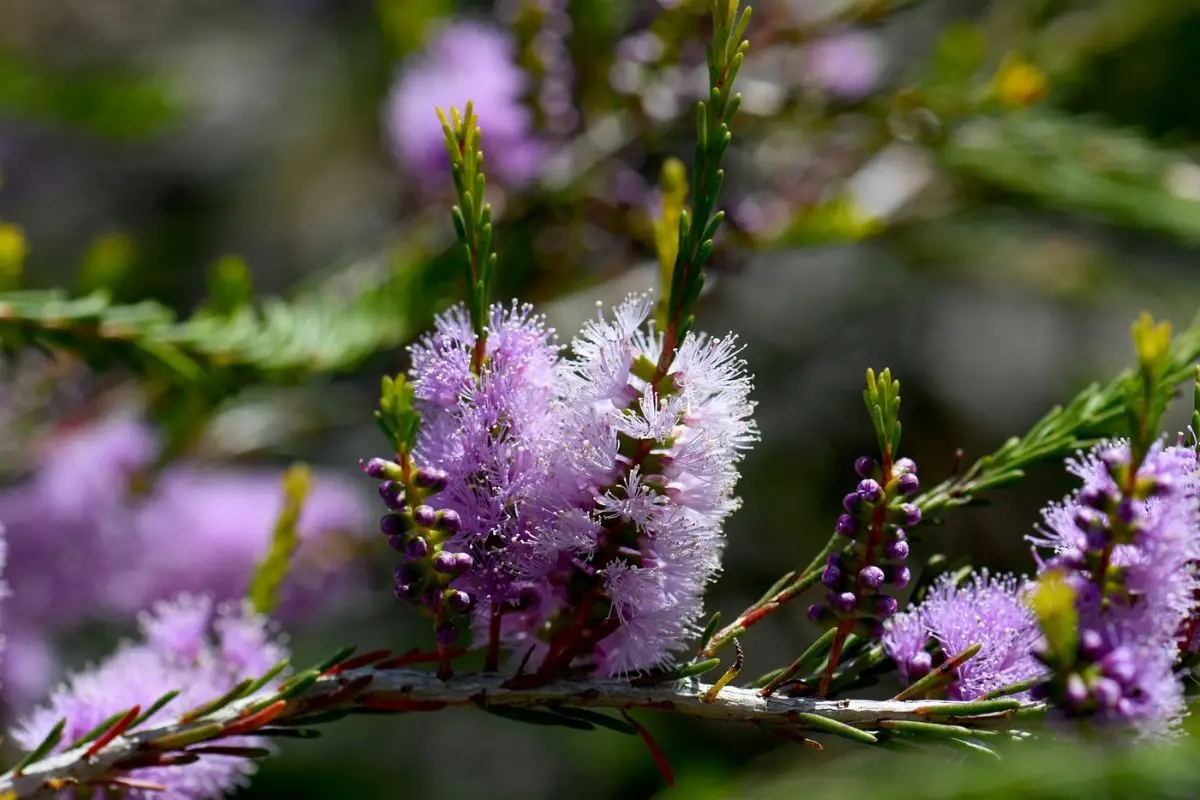Beaufortia is a genus of around 20 small trees and woody shrubs that is native to the southwest of Australia. This is an evergreen plant that is widely grown elsewhere with little effort.
This perennial is grown both for its evergreen foliage and bright red, orange or pinky flowers that resemble a bottle brush.
Whilst the beaufortia has similar flowers to the callistemon (also commonly known as bottlebrush), it is not the same plant. Callistemons also belong to the myrtle family and have alternate leaves, whilst beaufortia has opposite leaves.
History
This shrub was first formally described in the early 1800s. It was named after an English botanist, the Duchess of Beaufort, who had developed a prized botanical garden in Gloucestershire.
Plant Facts
| Scientific name | Beaufortia sparsa Beaufortia squarrosa, Beaufortia aestiva Beaufortia purpurea Beaufortia elegans |
| Common names | Swamp bottlebrush, Gravel bottlebrush Sand bottlebrush |
| Genus | Beaufortia |
| Family | Myrtaceae |
| Height | 3 to 10 feet (3.05 m) |
| Width | 1 to 3 feet (0.91 meters) |
| USDA Plant Hardiness Zone | Zones 8 to 11 |
| Native to | Western Australia |
| Blooming season | Spring to summer |
| Flower colors | Red, purple, orange, pink |
| Plant specific features | Fragrant flowers, evergreen foliage |
How to Plant and Grow
This is a plant that grows naturally in Western Australia. It will grow in containers in warmer climates as well as in mixed borders.
Where to Plant
These plants are ideal for rocky hillsides, and sloping land. If planted outside, they need some winter protection as they are not fully hardy.
Alternatively, plant beaufortia in containers where they can be moved inside during the cooler periods. They are excellent specimen plants for a greenhouse.
When to Plant
In the autumn months, you can grow this plant from seed relatively easily. Alternatively, plant a container plant in the spring to benefit from the flowering period in late spring and summer.
Care and Maintenance
Soil
Soil requirements are minimal; the beaufortia will do well in any soil, providing it is well-draining. It especially likes limestone or granite soils. You can add pebbles around the base of the plant to increase drainage and retain heat in the soil around the roots.
Water
Until the plant is well-established, it should be watered regularly. Once the beaufortia has established its strong root system, it is drought tolerant.
Fertilizer
This is a plant that in its native environment grows in poor soil; however, an annual application of a general purpose, slow-release fertilizer at the start of the growing season will prove beneficial.
Sunlight
Plant the beaufortia in as sunny a position as possible. It will tolerate a site that is in partial shade but prefers full sun. The more sun it receives, the better the flowering will be.
Pruning and Repotting
Not much pruning is required for this plant. It can be grown as a multi-trunked shrub, or you can prune it back to one trunk only, to grow it as a specimen, a small tree.
Pruning should be carried out in the summer, once flowering has finished. You should prune the new wood on the outside of the plant. If desired, shape the beaufortia by cutting the tips off the new branches.
You can also remove the flowers and use them as cut flowers. This will result in pruning the plant at the same time.
Propagating
You can increase your number of showy beaufortia plants easily, either from seeds or cuttings. The seeds are easy to grow once you have extracted them from their woody capsules!
In their native habitat, beaufortia will only release its seeds after the fire. Try putting the capsules in a coffee grinder and sow the resulting grains, which will contain the seeds.
The surface sows the seeds as they need light for successful germination. Germination should take place between two and eight weeks. Keep the seeds moist and in a light location but out of direct sunlight.
Alternatively, propagate the shrub by taking cuttings. You can either take softwood or semi-ripe cuttings in the spring.
Pests and diseases
There are no major pest or disease problems associated with this shrub.
Temperature and Humidity
Beaufortia is not fully hardy. It grows best in warm conditions, and will not survive below USDA zone 8 or 9. You can grow it as a houseplant or provide a protected, sheltered position for the cooler months if you live in a region below USDA Zone 8.
Other Uses for Beaufortia
Beaufortia sparsa is a plant that provides showy and fragrant flowers for a long period. It is ideal in a mixed planting scheme or as a plant to use for screening purposes.
This beautiful plant is a useful addition if you want to encourage wildlife, and equally good planted to control soil erosion.
Types of Beaufortia You Can Grow
Whilst there are around 25 plants in the genus, only a few are widely grown. The versatility of the swamp bottle brush makes this one of the most popular choices.
B. squarrosa “Orange” is commonly known as the sand bottlebrush. This variety has showy orange flowers and attractive foliage. The shrub is small and has a spreading habit.
Conclusion
This fragrant, evergreen shrub is a useful and attractive addition with its use as a cut flower, winter color, and low-maintenance needs.
If you are in a cooler zone, consider planting the beaufortia as a container plant and over-winterizing it in a greenhouse.
*image by KHBlack/depositphotos

